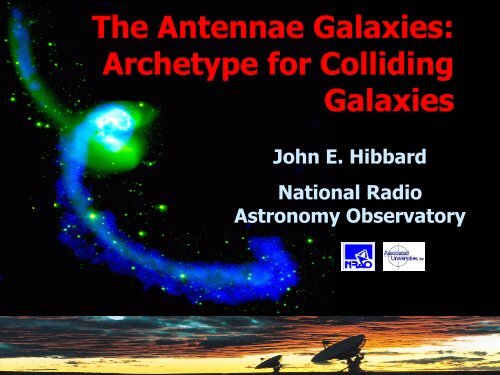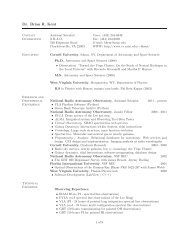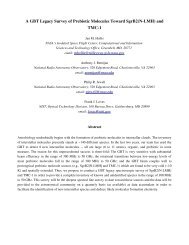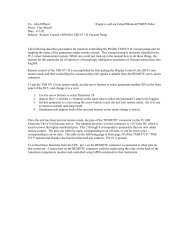The Antennae Galaxies: Archetype for Colliding Galaxies
The Antennae Galaxies: Archetype for Colliding Galaxies
The Antennae Galaxies: Archetype for Colliding Galaxies
Create successful ePaper yourself
Turn your PDF publications into a flip-book with our unique Google optimized e-Paper software.
<strong>The</strong> <strong>Antennae</strong> <strong>Galaxies</strong>:<br />
<strong>Archetype</strong> <strong>for</strong> <strong>Colliding</strong><br />
<strong>Galaxies</strong><br />
John E. Hibbard<br />
National Radio<br />
Astronomy Observatory
<strong>The</strong> <strong>Antennae</strong>: A Merger <strong>Archetype</strong> J. Hibbard, NRAO 203 rd AAS Jan 9 2004<br />
Punch line: We present a new model of the interacting<br />
galaxy NGC 4038/39 (“<strong>The</strong> <strong>Antennae</strong>”). This is the first<br />
realistic model which matches both the observed shape<br />
and motions of the tidal features.<br />
Observations<br />
New Simulation
<strong>The</strong> <strong>Antennae</strong>: A Merger <strong>Archetype</strong> J. Hibbard, NRAO 203 rd AAS Jan 9 2004<br />
Historical Background: NGC 4038/39<br />
• 1830’s: Cataloged as entires<br />
4038, 4039 in the New General<br />
Catalog (NGC).<br />
• 1922: brief description by Perrine,<br />
`Notes on Four Interesting<br />
Nebulae’: “Hook extending out<br />
from a Ring”.<br />
• 1923: first description in terms of<br />
“<strong>Antennae</strong>” by Duncan.<br />
• 1940: first description in terms of<br />
tidal interaction by Holmberg.<br />
• 1972: first referred to as “<strong>The</strong><br />
<strong>Antennae</strong>” by Toomre & Toomre,<br />
who also present the first<br />
interaction model able to<br />
reproduce crossed tails.<br />
NGC 4038<br />
NGC 4039<br />
Sketch from Zwicky, 1954, Ergebnisse der exakten<br />
Naturwissenschaften, 29, 344
Ever since Toomre & Toomre<br />
(1972), <strong>The</strong> <strong>Antennae</strong> has<br />
been a key system <strong>for</strong><br />
validating the once<br />
controversial idea that<br />
galaxies can and do merge<br />
<strong>The</strong> <strong>Antennae</strong>: A Merger <strong>Archetype</strong> J. Hibbard, NRAO 203 rd AAS Jan 9 2004
<strong>The</strong> <strong>Antennae</strong>: A Merger <strong>Archetype</strong> J. Hibbard, NRAO 203 rd AAS Jan 9 2004<br />
Challenges to Collisional Interpretation<br />
• 1962, IAU 15, 194,<br />
Vorontsov-<br />
Velyaminov<br />
– Tails too long and<br />
thin to be tidal<br />
• Refuted: 1978,<br />
Schweizer<br />
– Tails not as thin as<br />
you think
Challenges to Collisional Interpretation<br />
• 1976, 1977<br />
Vorontsov-<br />
Velyaminov<br />
– Not two (obvious)<br />
progenitors<br />
• Refuted: 1990,<br />
Stan<strong>for</strong>d &<br />
Bushouse (use<br />
NIR to look<br />
through dust)<br />
B. Brandt & WIRC team<br />
(Cornell; APOD 2002-Apr-11)<br />
<strong>The</strong> <strong>Antennae</strong>: A Merger <strong>Archetype</strong> J. Hibbard, NRAO 203 rd AAS Jan 9 2004
NGC 4038/39 is the first member of<br />
“Toomre Sequence” of merging galaxies<br />
Toomre, 1977, “Evolution of <strong>Galaxies</strong> &<br />
Stellar Populations”, 401<br />
• Suggestive sequence of<br />
peculiar galaxies<br />
representing the concept<br />
that two spiral galaxies<br />
could merge and evolve<br />
into an elliptical galaxies<br />
(<strong>The</strong> Toomre “Merger<br />
Hypothesis”)<br />
• Also closest member;<br />
may represent our best<br />
chance <strong>for</strong> understanding<br />
merging galaxies<br />
HST imaging of<br />
Toomre<br />
Sequence by<br />
Laine et al.<br />
2003, AJ, 126,<br />
2717<br />
<strong>The</strong> <strong>Antennae</strong>: A Merger <strong>Archetype</strong> J. Hibbard, NRAO 203 rd AAS Jan 9 2004
<strong>The</strong> <strong>Antennae</strong>: A Merger <strong>Archetype</strong> J. Hibbard, NRAO 203 rd AAS Jan 9 2004<br />
Modeling History<br />
1972, Toomre & Toomre, test particles<br />
Observations<br />
1988, Barnes, self-consistent<br />
1993, Mihos et al.,<br />
Self-consistent+gas dynamics<br />
1996, Dubinski,<br />
Self-consistent,<br />
parabolic encounter
<strong>The</strong> <strong>Antennae</strong>: A Merger <strong>Archetype</strong> J. Hibbard, NRAO 203 rd AAS Jan 9 2004<br />
New modeling ef<strong>for</strong>t made possible by sensitive, high resolution<br />
observations of the cold atomic gas using the National Science<br />
Foundations Very Large Array (VLA) telescope<br />
Blue=VLA HI Observations<br />
Hibbard, van der Hulst, Barnes & Rich 2001, AJ, 122, 2969<br />
Simulation<br />
Blue=disk particles Red=halo particles
<strong>The</strong> <strong>Antennae</strong>: A Merger <strong>Archetype</strong> J. Hibbard, NRAO 203 rd AAS Jan 9 2004<br />
Our model is the first detailed match to the observed<br />
shape and motions of the tidal tails, using realistic<br />
galaxy models and starting conditions<br />
Yellow=HI data points<br />
(position and velocity)<br />
Red & Blue=simulation<br />
data points<br />
e=0.5 orbit<br />
(elliptical)<br />
e=1 orbit<br />
(parabolic)
Time Evolution<br />
http://www.ifa.hawaii.edu/~barnes/pressrel/antfacts/<br />
1 million<br />
particle<br />
simulation<br />
of best<br />
fitting<br />
parameters<br />
System made first pass ~220 Myr ago; will merge in ~40 Myr<br />
<strong>The</strong> <strong>Antennae</strong>: A Merger <strong>Archetype</strong> J. Hibbard, NRAO 203 rd AAS Jan 9 2004
3-dimensional structure of <strong>The</strong> <strong>Antennae</strong><br />
http://www.ifa.hawaii.edu/~barnes/pressrel/antfacts/<br />
<strong>The</strong> <strong>Antennae</strong>: A Merger <strong>Archetype</strong> J. Hibbard, NRAO 203 rd AAS Jan 9 2004
<strong>The</strong> <strong>Antennae</strong>: A Merger <strong>Archetype</strong> J. Hibbard, NRAO 203 rd AAS Jan 9 2004<br />
3-dimensional structure of <strong>The</strong> <strong>Antennae</strong><br />
may help explain some outstanding puzzels<br />
Young star clusters
<strong>The</strong> <strong>Antennae</strong>: A Merger <strong>Archetype</strong> J. Hibbard, NRAO 203 rd AAS Jan 9 2004<br />
Our new model is an important step<br />
towards increasing our understanding<br />
of this merger archetype<br />
• First model which matches both the observed<br />
shape and motions of <strong>The</strong> <strong>Antennae</strong> tidal<br />
features in detail.<br />
• Parabolic orbit much more plausible starting<br />
condition<br />
• Time evolution can be compared to data from<br />
star clusters/populations/element enrichment<br />
• 3-d d structure can help us understand some<br />
outstanding puzzels





